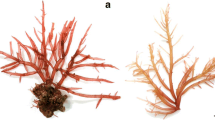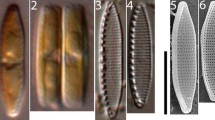Abstract
In situ photosynthetic activity in the green algal and the cyanobacterial photobionts of Placopsis contortuplicata was monitored within the same thallus using chlorophyll a fluorescence methods. It proved possible to show that the response to hydration of the green algal and the cyanobacterial photobionts is different within the same thallus. Measurements of the photochemical efficiency of PS II, Fv/Fm, reveal that in the dry lichen thallus photosynthetic activity could be induced in the green algal photobiont by water vapour uptake, in the cyanobacterial photobiont only if it was hydrated with liquid water. However, rates of apparent electron flow through PS II as well as rates of CO2 gas exchange were suboptimal after hydration with water vapour alone and maximum rates could only be observed when the thallus was saturated with liquid water. The differences in the waterrelated photosynthetic performance and different light response curves of apparent electron transport rate through PS II indicate that the two photobionts act highly independently of each other. It was shown that the cyanobacteria from the cephalodia in P. contortuplicata act as photobiont. The rate of electron flow through PS II was found to be saturated at 1500 μmol photon m−2 s−1, despite a considerable increase of non-photochemical quenching in the green algal photobiont which is lacking in the cyanobacterial photobiont. No evidence of photoinhibition could be found in either photobiont. Pronounced competition between the green algal and the cyanobacterial thallus can be observed in the natural habitat, indicating that the symbiosis in P. contortuplicata should be regarded as a very variable adaptation to the extreme environmental conditions in the maritime Antarctic.
Similar content being viewed by others
Abbreviations
- DR :
-
dark respiration
- ETR :
-
apparent rate of electron flow of PS II (=ΔF/Fm′×PFD)
- ΔF :
-
difference in yield of fluorescence and maximal Fm′ and steady state Fs under ambient light
- Fo:
-
minimum level of fluorescence yield in dark-adapted state
- Fo′:
-
minimum level of fluorescence yield after transient darkening and far-red illumination
- Fm :
-
maximum level of dark-adapted fluorescence yield
- Fm′ :
-
maximum yield of fluorescence under ambient light
- Fs :
-
yield of fluorescence at steady state
- Fv :
-
difference in minimum fluorescence and maximum fluorescence in dark-adapted state
- NP :
-
net photosynthesis
- NPQ :
-
coefficient for non-photochemical quenching
- PAR :
-
photosynthetically active radiation (400–700 nm)
- PFD :
-
photon flux density in PAR
- PS II :
-
photosystem II
- qN :
-
coefficient for non-photochemical quenching
- qP :
-
coefficient for photochemical quenching
References
Badger MR, Pfanz H, Büdel B, Heber U, Lange OL (1993) Evidence for the functioning of photosynthetic CO2-concentrating mechanisms in lichens containing green algal and cyanobacterial photobionts. Planta 191:59–72
Bolhàr-Nordenkampf HR, Long SP, Baker NR, Öquist G, Schreiber U, Lechner EG (1989) Chlorophyll fluorescence as a probe of the photosynthetic competence of leaves in the field: a review of current instrumentation. Funct Ecol 3:497–514
Büdel B, Lange OL (1991) Water status of green and blue-green phycobinots in lichen thalli after hydration by water vapour uptake: Do they become turgid? Bot Acta 104:361–366
Coxson DS (1987) Effects of desiccation on net photosynthetic activity in the basidiomycete lichen Cora pavonia E. Fries from the cloud/mist zone of the tropical volcano La Soufrière (Gùadeloupe). Bryologist 90:241–245
Demming-Adams B, Adams III WW, Green TGA, Czygan F-C, Lange OL (1990a) Differences in the susceptibility to light stress in two lichens forming a phycosymbiodeme one partner possessing and one lacking the xanthophyll cycle. Oecologia 184:451–456
Demmig-Adams B, Máguas C, Adams III WW, Meyer A, Kilian E, Lange OL (1990b) Effect of high light on the efficiency of photochemical energy conversion in a variety of lichen species with green and blue-green phycobionts. Planta 180:400–409
Genty B, Briantais J-M, Baker N (1989) The relationship between the quantum yield of photosynthetic electron transport and quenching of chlorophyll fluorescence. Biochim Biophys Acta 990:87–92
Green TGA, Büdel B, Heber U, Meyer A, Zellner H, Lange OL (1993) Differences in photosynthetic performance between cyanobacterial and green algal components of lichen photosymbiodemes measured in the field. New Physiol 125:723–731
Hawes I, Howard-Williams C, Vincent WF (1992) Desiccation and recovery of Antarctic cyanobacterial mats. Polar Biol 12: 587–594
Inoue M (1991) Ecological notes on the differences in flora and habitat of lichens between the Syowa Station area in continental Antarctic and King George Island in martime Antarctic. Proc NIPR Symp Polar Biol 4:91–106
James PW, Henssen A (1976) The morphological and taxonomic significance of cephalodia. In: Brown DH, Hawksworth DL, Bailey RH (eds) Lichenology. Progress and problems. Academic Press, London New York San Francisco, pp 27–77
Jensen M, Feige GB (1987) The efect of desiccation and light on the 77K chlorophyll fluorescence properties of the lichen Peltigera aphthosa. Bibl Lichenol 25:325–330
Kappen L (1988) Ecophysiological relationships in different climatic regions. In: Galun M (ed) CRC Handbook of lichenology. CRC Press, Boca Raton Florida, pp 37–100
Kappen L (1993) Lichens in the Antarctic region. In: Friedmann EI (ed) Antarctic microbiology. Wiley-Liss, New York, pp 433–490
Kappen L, Bölter M, Kühn A (1987) Photosynthetic activity of lichens in natural habitats in the maritime antarctic. In: Peveling E (ed) Progress and problems in lichenology in the eighties. (Bibl Lichenol 25). J Cramer, Berlin Stuttgart, pp 297–312
Kappen L, schroeter B, Sancho LG (1990) Carbon dioxide exchange of Antarctic crustose lichens in situ measured with a CO2/H2O porometer. Oecologia 82:311–316
Krause GH, Weis E (1991) Chlorophyll fluorescence and photosynthesis: the basics. Annu Rev Plant Physiol Plant Mol Biol 43:313–349
Lamb IM (1947) A monograph of the lichen genus Placopsis Nyl. Lilloa 13:151–288
Lange OL, Kilian E (1985) Reaktivierung der Photosynthese trockener Flechten durch Wasserdampfaufnahme aus dem Luftraum: Artspezifisch unterschiedliches Verhalten. Flora 176:7–23
Lange OL, Tenhunen JD, Harley P, Walz H (1985) Method for field measurements of CO2-exchange. The diurnal changes in net photosynthesis and photosynthetic capacit of lichens under mediterranean climatic conditions. In: Brown DH (ed) Lichen physiology and cell biology. Plenum Press, New York London, pp 23–40
Lange OL, Kilian E, Ziegler H (1986) Water vapour uptake and photosynthesis of lichens: performance differences in species with green and blue-green algae as phycobionts. Oecologia 71: 104–110
Lange OL, Green TGA, Ziegler H (1988) Water status related photosynthesis and carbon isotope discrimination in species of the lichen genus Pseudocyphellaria with green or blue-green photobionts and in photosymbiodemes. Oecologia 75: 494–501
Lange OL, Bilger W, Rimke S, Schreiber U (1989) Chlorophyll fluorescence of lichens containing green and blue-green algae during hydration by water vapour uptake and by addition of liquid water. Bot Acta 102:306–313
Lange OL, Pfanz H, Kilian E, Meyer A (1990a) Effect of low water potential on photosynthesis in intact lichens and their liberated algal components. Planta 182:467–472
Lange OL, Kilian E, Ziegler H (1990b) Photosynthese von Blattflechten mit hygroskopischen Thallusbewegungen bei Befeuchtung durch Wasserdampf oder mit flüssigem Wasser. In: Jahns HM (ed) Contributions in lichenology. In honour of A. Henssen (Bibl Lichenol 38). J Cramer, Berlin Stuttgart, pp 311–323
Lange OL, Büdel B, Meyer A, Kilian E (1993) Further evidence that activation of net photosynthesis by dry cyanobacterial lichens requires liquid water. Lichenologist 25:175–189
Palmqvist K (1993) Photosynthetic CO2-use efficiency in lichens and their isolated photobionts: the possible role of a CO2-concentrating mechanism. Planta 191:48–56
Redon J (1985) Líquenes Antárticos. INACH, Santiago de Chile
Renner B, Galloway DJ (1982) Phycosymbiodemes in Pseudocyphellaria in New Zealand. Mycotaxon 16:197–231
Sancho LG, Kappen L, Schroeter B (1990) Primeros datos sobre la flora y vegetacion líquenica de Isla Livingston (Islas Shetland del Sur Antártida). Actas del Symposium Español de Estudios Antárticos Madrid 3:94–99
Schreiber U, Bilger W, Klughammer C, Neubauer C (1988) Application of the PAM fluorometer in stress detection. In: Lichtenthaler KH (ed) Applications of chlorophyll fluorescence. Kluwer Academic, The Hague, pp 151–155
Schroeter B (1991) Untersuchungen zu Primärproduktion und Wasserhaushalt von Flechten der maritimen Antarktis unter besonderer Berücksichtingung von Usnea antarctica DuRietz. Dissertation, Universität Kiel
Schroeter B, Kappen L, Moldaenke C (1991a) Continuous in situ recording of the photosynthetic activity of Antarctic lichens-established methods and a new approach. Lichenologist 23: 253–265
Schroeter B, Jacobsen P, Kappen L (1991b) Thallus moisture and microclimatic control of the CO2-exchange of Peltigera aphthosa (L.) Willd. on Disko Island (West Greenland). Symbiosis 11:131–146
Schroeter B, Green TGA, Seppelt RD, Kappen L (1992) Monitoring photosynthetic activity of crustose lichens using a PAM-2000 fluorescence system. Oecologia 92:457–462
Schroeter B, Green TGA, Kappen L, Seppelt RD (1994) Carbon dioxide exchange at subzero temperatures. Field measurements on Umbilicaria aprina in Antarctica. Cryptogam Bot 4: 233–241
Winter K, Lesch M (1992) Diurnal changes in chlorophyll a fluorescence and carotenoid composition in Opuntia ficus-indica, a CAM plant, and in three C3 species in Portugal during summer. Oecologia 91:505–510
Author information
Authors and Affiliations
Rights and permissions
About this article
Cite this article
Schroeter, B. In situ photosynthetic differentiation of the green algal and the cyanobacterial photobiont in the crustose lichen Placopsis contortuplicata . Oecologia 98, 212–220 (1994). https://doi.org/10.1007/BF00341474
Received:
Accepted:
Issue Date:
DOI: https://doi.org/10.1007/BF00341474




